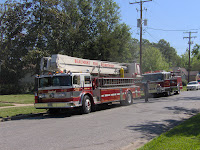
It seems a little late that people here in Beaumont, Texas, are beginning to notice that the firefighters might have a good reason for wanting enough staff on a truck. Firefighter Cody Schroeder is undergoing what is surely agonizing treatment for the burns he suffered Monday during a fire in which he and five other of his fire department members were injured. The 27-year-old Schroeder suffered burns to 40 percent of his body when a structure blaze flashed over.
Continuing difficulties in negotiations between the city of Beaumont and the firefighters’ union has included demands that fire trucks be staffed with four suppression personnel. Such goals aren’t really pie-in-the-sky wishes by greedy union men. Numerous studies have prompted fire safety associations for years to call for minimum engine staffing standards. The “fire staffing” debate was one of the big issues when I worked as a firefighter more than 20 years ago. Cities whose politicians rightly worry about trivial matters such as taxes often feel like having enough firefighters or police officers to safely do their jobs is some kind of luxury. And even in a number of cases, the police may fare better getting what they want from the cities. Maybe it’s because they carry guns.
Although the Beaumont fire union president stated yesterday that having four firefighters to an engine company would not have made a difference in the incident involving the injuries, plenty of evidence exists that it is definitely safer to have more personnel on the fire scene.
“A study conducted by the Seattle Fire Department found that the severity of fire fighter injuries declined 35% when staffing per apparatus was increased from 3-person crews to 4-person crews,” Michael McNeill testified before a congressional panel in 2004. McNeill, a district vice president of the International Association of Fire Fighters, retired after 33 years with the Denver Fire Department. “A study by the Dallas Fire Department found a direct correlation between staffing levels and both the safety and effectiveness of emergency response operations. Specifically, the Dallas study found that inadequate staffing delays or prevents the performance of critical tasks, increases the physiological stress on fire fighters, and increases the risk to both civilians and fire fighters. After analyzing their data, the authors of the Dallas study concluded, “staffing below a crew size of four can overtax the operating force and lead to higher losses.”
McNeill’s testimony also indicated the fire staffing debate even goes to the heart of cities adequately preparing for terrorist attacks.
“The National Fire Protection Association (NFPA)-the consensus, standard making body of the fire service-recently completed a report entitled “Preparing for Terrorism: Estimated Costs to U.S. Local Fire Departments.” The study found that an additional 75,000 to 85,000 fire fighters are needed to fully staff fire departments to be able to safely respond to traditional emergencies and to minimally respond to terrorist incidents, said McNeill.”
I won’t hold my breath that the Beaumont City Council will come around to the side of sanity and institute a decent staffing level on the city’s fire engines. So incidents such as Monday’s flashover which injured six of our firefighters could very well repeat itself. Especially considering how much the department was zapped Monday after the structure fire, followed by a truck exploding after it ran off I-10 into Ida Reed Park. The driver of that truck was killed although no firefighter injuries were reported. As bad as Monday was for Beaumont firefighters, the outcome could be even worse next time.
